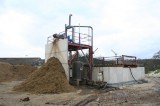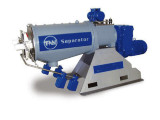Separation is the answer to slurry storage, handling and utilisation issues on West Sussex dairy farm.
Separating the constituents of slurry into liquid and solids has transformed management of cattle waste on a West Sussex dairy farm. It not only resolved a looming storage capacity issue, it has also turned a waste management headache into an easily-handled resource that will improve the land and cut fertiliser costs.
“We can now utilise the nutrients and dry matter in slurry to our advantage anywhere on the farm,” says Neil Harrison. “Before we started using a FAN screw press separator, slurry was just something that gave us a lot of problems.”
The family farming partnership R Harrison & Sons operates three dairy units near Horsham with a total of 1100 mainly Jersey-Friesian crosses on 2200 acres of owned and rented land. Being three to four miles apart, the dairy units are largely self-contained as far as day-to-day operations are concerned but close enough to share forage supplies and equipment.
The inspiration for a new approach to slurry management came when the farm workshop fabricated a gantry to house a separator for a neighbouring farm’s new biogas plant.
“We then saw separation as a considerable step forward from the nightmare of dealing with muck,” says Neil Harrison. “We were facing a shortfall in capacity to meet Nitrate Vulnerable Zone rules and we weren’t utilising the nutrients in muck to help offset the rising cost of mineral fertilisers. It helped us reassess what we needed to do.”
Proven concept
The concept was proven after the installation of a PSS 3.2-780 screw press from FAN Separator, which instantly relieved the marginal capacity of an old sleeper-walled lagoon on the family’s 500-cow unit at Pallinghurst Farm. Attention then turned to the 400-cow operation at nearby Dedisham Farm, where a large area of open concrete adds to the volume of winter waste.
“The cows on this unit, where we installed a second FAN separator, take self-feed silage from open air clamps,” notes Neil Harrison. “The cubicle housing, feeding and loafing areas are scraped three times a day and with around half an acre of concrete in front of the cubicle sheds and 32-33in of rainfall, we’re collecting a lot of liquid.”
Slurry and parlour washings were collected in a 2500cu m earth-walled lagoon, where attempts to drain off liquid through a weeping wall for field application by tanker was not very successful.
“It left us with a big quantity of very sloppy ‘solids’ that we dug out using our own hydraulic excavator,” Mr Harrison recalls. “The farm is divided by a busy main road and has plenty of non-farming neighbours, so spreading operations could not extend to all parts of the farm without causing a lot of mess and upset.”
Today, the scene is very different. Instead of a vast slurry lake, the concrete-floored lagoon now houses a 150cu m slurry reception tank and provides storage for the light, dry fibrous material extracted by the separator mounted high on a steel gantry alongside.
The liquid fraction is pumped to a new 20,000cu m reservoir before being applied to nearby land by dirty water irrigator and farther afield by a contractor’s vacuum tanker or umbilical application system.
“Solids are pushed away to storage and in two weeks turn black like compost; the smell goes completely,” reports Mr Harrison. “It stacks up nicely in a spreader, so we can put it on maize fields across the main road or up to seven miles away on very hungry ground where it provides some much-needed fibre and nutrients.”
Separator choice
Having dismissed roller screen separators because of concerns over running and long term maintenance and repair costs, the screw press was selected from the four-model 3.2 Series heavy-duty range made by FAN Separator, a business unit of the Bauer Group.
It was supplied along with most other equipment by FAN dealer Negus Chase at Staplehurst, Kent, and all installation, including groundworks, was handled by the resourceful Harrison family.
The FAN PSS 3.2-780 press screw separator has several patented features, including an oscillator that transmits pressure pulses into the inlet chamber to assist separation of sticky waste materials.
“A separator is not something you set going and forget about because it’s important for efficiency to get the correct slurry consistency,” Mr Harrison emphasises. “It works best when the slurry is very sloppy and flows easily, so apart from being able to circulate and mix the tank contents, we can also direct separated water back into the tank to dilute it if necessary.”
Pumping performance
Pump specification and performance is another key factor and after repeated blockages with another manufacturer’s pump, the unit was replaced by a new design from FAN Separator, the Magnum CSPH.
Purpose-designed to handle fluids with high solids content, this electric-drive submersible centrifugal impeller pump features a high-flow inlet and externally-adjustable cutter plate. It is reckoned to be highly power-efficient, giving equivalent performance for 2kW less power in some cases.
An automatic seal operating within an oil-filled chamber protects the motor, with automatic low oil level warning and shut-down guarding against oil loss.
“The new pump’s been a great success,” says Mr Harrison. “The previous one was a source of some frustration but this one hasn’t missed a beat.”
The fully submerged pump is activated by a ‘magic eye’ level sensor that leaves 1.2m of liquid in the tank at all times. It starts up automatically along with the separator between set times during the day once slurry depth exceeds 1.5m.
“If we have a problem, there’s three days’ spare capacity in the reception tank and we could always run slurry into part of the lagoon if necessary,” says Neil Harrison. “In practice, apart from the occasional blockage in a feed pipe, the separation system has run very reliably and consistently.”
The FAN separator itself has particularly impressed, he adds.
“We’re very much into good engineering here – we fabricated the gantry ourselves and always tend to have machinery more than capable for the job,” Mr Harrison points out. “FAN produces equipment for industrial applications, so that gave us confidence using it for a farming application. It looks very well engineered, so I’m confident we’ll get a long service life.”
The separator deals easily with the 20-25cu m of slurry and dirty water that enters the tank with each milking in about four hours, he reports. Running costs are calculated at £2/hr (17-18kW at 10p/unit), a figure Neil Harrison considers perfectly acceptable for the seven to eight hours a day the machine operates.
Despite being offset by a regional development agency grant, the £70,000 cost of all plant, plus the supporting infrastructure, still represents a significant investment.
“But the benefits we’re getting are tremendous,” Mr Harrison emphasises. “It’s resolved our storage capacity issue, has cleaned up the farm and enables us to make proper use of a resource that’s improving the fertility and productivity of our land.”
The separator in detail
The Press Screw Separator 3.2-780 is one of four models in the FAN 3.2 Series; output is 40% higher than the smallest model in the line-up, the 3.2-520, and there are two larger units. The stainless steel screw is driven by a 5.5kW or 7.5kW motor through a gearbox.
Six screen slot sizes from 0.1mm to 1.0mm are available, plus half-screens for different dual- or triple-screen options within the same unit.
Slurry enters from above through a 100mm (4in) inlet, where an adjoining oscillator unit transmits pressure pulses to the slurry to maintain its fluidity.
As liquid drains through a stainless steel wire screen, a plug of fibrous material is continuously formed and itself forms a filter to capture smaller particles. Tight tolerances ensure the screen is repeatedly cleaned by the screw to maintain free liquid flow.
Friction between the solids plug and cylindrical mouth-piece, together with the weighted flaps at the outlet, create counter-pressure for forced de-watering. This process can be fine-tuned by adjusting the weights to suit materials with solids content from just 0.1% to thick slurries with 20% solids.
All major components are made from stainless steel; the screw flights are hard-coated for low wear and durability.








